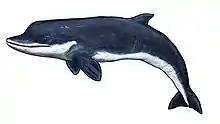| Physeterula Temporal range: Miocene | |
|---|---|
| Scientific classification | |
| Domain: | Eukaryota |
| Kingdom: | Animalia |
| Phylum: | Chordata |
| Class: | Mammalia |
| Order: | Artiodactyla |
| Infraorder: | Cetacea |
| Family: | Physeteridae |
| Subfamily: | Physeterinae |
| Genus: | †Physeterula Van Beneden, 1877 |
| Species | |
|
P. dubusi | |
Physeterula was a prehistoric close relative of the sperm whale from the Miocene. Its fossils have been found in Europe and the United States.[1]
This large species is the most stemward physeterid, retaining functional upper teeth lacking enamel.[2]
References
- ↑ "Fossilworks: Physeterula".
- ↑ Lambert, Olivier (January 2008). "Sperm whales from the Miocene of the North Sea: A re-appraisal". Bulletin de l'Institut Royal des Sciences Naturelles de Belgique, Sciences de la Terre. 78: 277–316.
This article is issued from Wikipedia. The text is licensed under Creative Commons - Attribution - Sharealike. Additional terms may apply for the media files.

